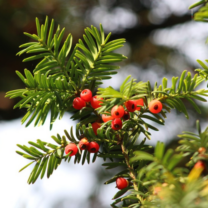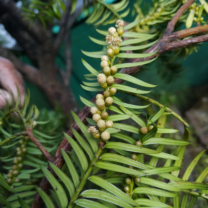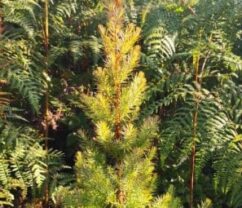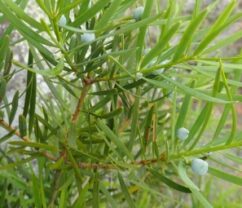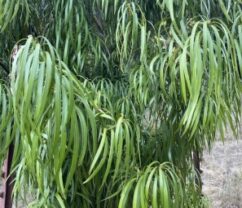TOP EDGE
East Himalayan Yew
Taxus wallichiana
The East Himalayan Yew is a rare conifer found in Nepal, Bhutan, Northeast India, and Southwest China mountainous regions. This resilient tree is adapted to thrive in high-altitude forests’ damp, acidic soils, enduring some of the most challenging climatic conditions. Beyond its ecological importance and aesthetic beauty, the East Himalayan Yew is vital for its medicinal properties; it produces taxol, a crucial compound used in cancer therapies.
Conservation Attention
Low
Assam Catkin Yew
Amentotaxus assamica
The Assam Catkin Yew is a rare and enigmatic conifer native to the lush, forested regions of Northeast India. This understory tree thrives in the shaded and moist environments of subtropical forests, often found along stream banks and in ravines. It is distinguished by its unique catkin-like cones, from which it derives its name.
Conservation Attention
Very Low
Maire’s Yew
Taxus mairei
Maire’s Yew is a rare conifer native to Nepal, Assam, central and southern China, Hainan, Taiwan and Vietnam. This resilient tree thrives in rocky soils, adapting to some of the harshest environments. Beyond its ecological significance and visual appeal, Maire’s Yew is crucial for its medicinal value; it contains precursors to taxol, a compound pivotal in cancer treatment. The evergreen foliage and vibrant red berries sustain local wildlife and hold potential life-saving properties.
Conservation Attention
Low
Mulanje Cedar
Widdringtonia whytei
The Mulanje Cedar (Widdringtonia whytei) is a critically endangered conifer endemic to Mount Mulanje in southern Malawi. This striking tree, with its tall trunk and fragrant, durable wood, is the national tree of Malawi and holds deep ecological and cultural significance.
Conservation Attention
Very Low
Podocapus capuronii
Podocarpus capuronii
Podocarpus capuronii is a rare conifer endemic to the highlands of Madagascar. This tree inhabits montane forests and subalpine shrublands, thriving in nutrient-poor, sandy soil along streams, in ravines and on rocky slopes and ridges. Adapted to the island’s high-elevation ecosystems, it typically grows as a slow-growing shrub or stunted tree, though in forested areas, it can attain heights of up to 20 meters.
Conservation Attention
Very Low
Henkel’s Yellowwood
Henkel’s Yellowwood (Podocarpus henkelii) is a striking conifer endemic to the mistbelt forests of South Africa’s Eastern Cape and KwaZulu-Natal provinces. This evergreen tree is easily recognised by its gracefully drooping, dark blue-green leaves and tall, straight trunk, often reaching heights of 20 to 30 metres. It is one of South Africa’s tallest indigenous conifers and has long been valued both ecologically and ornamentally.
Conservation Attention
Very Low
